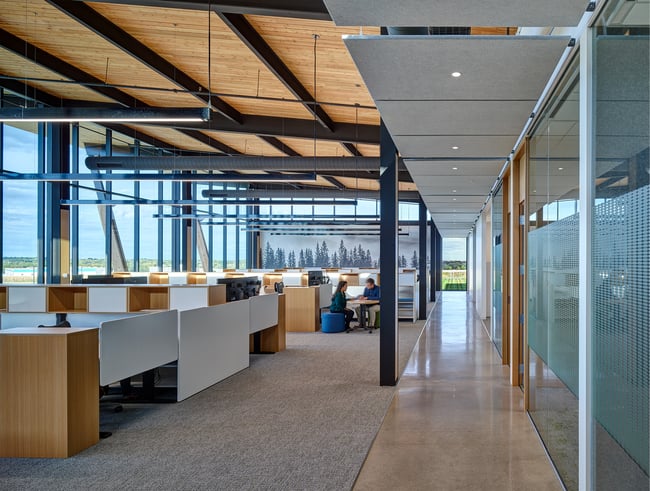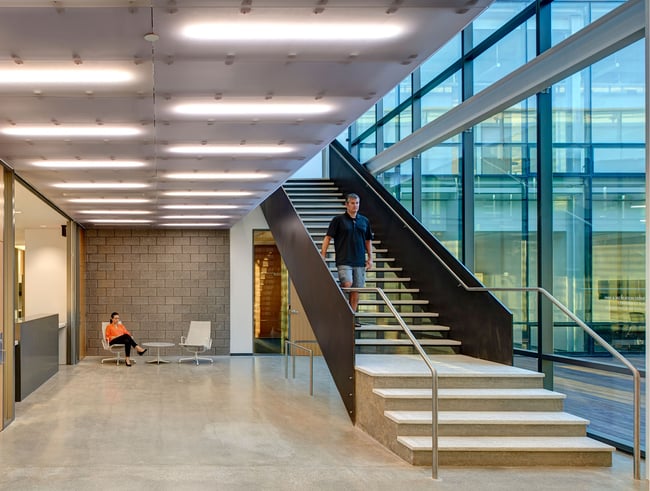WELL Building Standard in the Workplace: 10 Concepts

For employees, the most attractive companies are driven by purpose. Millennial and Gen Z workers are seeking organizations that contribute to social and environmental causes and demonstrate care for employees.
One path toward demonstrating care for employees is the WELL building standard. Backed by decades of research, WELL is a third-party certification system focused on occupant health and well-being. It provides a framework for improving air, water, and light quality while encouraging movement, social interaction, and healthy practices.
Like other building standards, certifications are based on the number of points achieved. Projects can earn points in ten categories known as concepts:
- Air
- Water
- Nourishment
- Light
- Movement
- Thermal comfort
- Sound
- Materials
- Mind
- Community
While some concepts focus on building design, others provide policy solutions. This article will discuss each category of the WELL building standard, helping you better understand how it can apply to your workplace.
10 WELL Concepts
1. Air
On average, people spend 90% of their time indoors—often in work environments with inadequate ventilation and no operable windows. Indoor pollutants, caused by off-gassing from building materials and machinery like copiers, can lead to headaches, nausea, and shortness of breath.
Long-term exposure can even exasperate respiratory illnesses like asthma. Over time, these health impacts add up, leading to decreased productivity and increased absenteeism.

The WELL standard presents solutions that improve indoor air quality. It sets standards for HVAC design, maintenance, and minimizing material off-gassing.
2. Water
Dehydration is a problem in many workplaces. A perceived lack of quality drinking water and the availability of sugary beverages leads many workers to forego water.
Studies show that dehydration can decrease mental performance, slow reaction times, and increase errors of judgment. A 3-4% decrease in hydration can cause a 25-50% performance decline.
The WELL building standard removes the barriers that lead to dehydration. It sets standards for water quality and makes piped drinking water more accessible. Workplaces should have at least one piped water dispenser within 100 feet of occupants.
3. Nourishment
The Nourishment concept is one area of the WELL building standard that focuses on administrative policies.
Healthy diets have the potential to prevent conditions like cardiovascular disease, high blood pressure, and diabetes. When considering health care costs, these chronic conditions can impact employers economically.
Research shows that people’s diets are largely influenced by the communities where they spend most of their time—including their workplaces. In workplaces that offer non-commercial dining options, WELL makes fruits, vegetables, whole grains, and non-sugary beverages more accessible to employees.
For example, workplaces should provide at least two varieties of fruits and vegetables and display them at eye level on the countertop or food service line.
4. Light
Light is a key determinant of human health. The circadian rhythm syncs with several environmental cues, most notably light.
Circadian rhythm disruption is linked to many health issues including obesity, diabetes, and metabolic conditions. Disruptions can also impact moods and increase symptoms of depression.
Most work environments are designed to meet the visual needs of individuals, and circadian rhythms are rarely considered.

The WELL standard prioritizes daylighting and views. In areas without natural light, or situations where employees work overnight, WELL pushes for circadian rhythm lighting that changes color temperatures to mimic daylight.
5. Movement
The Movement concept focuses on one of the most significant drivers of human health: physical activity. If physical activity was increased by 10% worldwide, we could avert more than half a million deaths.

To increase physical activity, the WELL standard promotes solutions like adjustable workstations and on-site bike storage. Stairs should also be the most obvious and attractive way to navigate the building.
In addition to these design solutions, employers should provide opportunities for employees to move throughout the day and offer wellness benefits, like gym reimbursement.
6. Thermal Comfort
Studies show that thermal comfort satisfaction leads to increased workplace productivity. On average, employee productivity decreases by 15% in hot conditions and 14% in cold conditions.
Thermal satisfaction is highly individualized and is affected by body type, clothing, and other factors. Although it is nearly impossible to make everyone comfortable, the WELL standard encourages employers to provide a temperature that at least 80% of occupants find acceptable. Generally, this is between 68- and 72-degrees Fahrenheit.
When possible, occupants should have control over their thermal conditions. Individual thermal zones, separate thermostats, and personal equipment like fans and space heaters enable occupants to find a comfortable temperature.
Employers should also create flexible dress code policies that allow occupants to dress in a way that best fits their needs.
7. Sound
Sound is an issue in many workplaces. In addition to exterior noises, occupants deal with enclosed sounds from HVAC equipment, appliances, and other occupants. Conversations readily transmit through an office, leading to distractions.
These issues can cause decreased productivity and lower memory retention. Studies show it can take up to 23 minutes to regain focus after a distraction.
The WELL standard offers ways to improve workplace acoustics. Adding massing and glazing to partition elements bolsters sound privacy and increases occupant comfort.
Replacing hard surfaces with more absorptive materials can prevent sound from traveling. Employers can also introduce consistent background noise by investing in sound-masking systems.
8. Materials
Building materials contain many compounds that are known to endanger human health. While chemicals like lead, asbestos, mercury, and chromated copper arsenate are largely restricted from use, they continue to pose risks in older structures. Volatile Organic Compounds (VOCs) are also common in insulation, paints, coatings, furnishings, and adhesives.
The WELL Materials concept requires projects to assess the presence of these compounds and take measures to prevent human exposure. It also encourages testing, remediation, and redevelopment of contaminated sites. The larger aim is to encourage market transformation toward healthier, sustainable products.
9. Mind
The Mind concept is another area that focuses on administrative policies. Compared to other illnesses, mental health conditions have longer delays in treatment onset. Unequal healthcare coverage, lack of awareness, and social stigma prevent many from seeking treatment.
Untreated mental health conditions have public health and economic consequences. Studies show that individuals with depression miss an average of 4.8 workdays and experience 11.5 days of decreased productivity in a three-month period. Mental health conditions can also prevent people from accessing preventative care like immunizations, cancer screenings, and tobacco cessation support.
The WELL standard encourages employers to offer equitable access to mental health services and encourage care utilization. It also encourages enhanced social support to enable a successful return for employees returning from leave due to a mental health condition.
In addition to these policies, employers should take measures to reduce stress and prevent burnout. Employees should have sufficient opportunities to detach and recover during non-work hours, like weekends, vacations, and evenings.
10. Community
The Community concept is perhaps the most comprehensive component of the WELL standard. It aims to support access to essential healthcare, build a culture of health that accommodates a diverse population, and establish an inclusive, engaged occupant community.
Across the world, many people struggle with low health literacy and limited access to basic services. Often, these problems are exacerbated by factors like race, ethnicity, socioeconomic status, and residential location.
The WELL standard promotes inclusive hiring practices, comprehensive and affordable healthcare plans, civic engagement, and health promotion programs. It also calls for an inclusive design process that engages occupants.
Learn More About Building Certification
The WELL building standard is an effective way to demonstrate your values and prioritize your employees. Its ten concepts help reduce absenteeism, improve productivity, and prevent burnout—leading to a tangible return on investment for employers.
The standard has also gained popularity with commercial developers. Improving air, light, sound, and thermal comfort quality can help attract tenants and improve property values.
The WELL standard is one of many building certification systems. Other systems—like LEED and Living Building Challenge—offer pathways for lowering operating costs and reducing environmental impacts. Learn more by reading about the most popular certification systems.